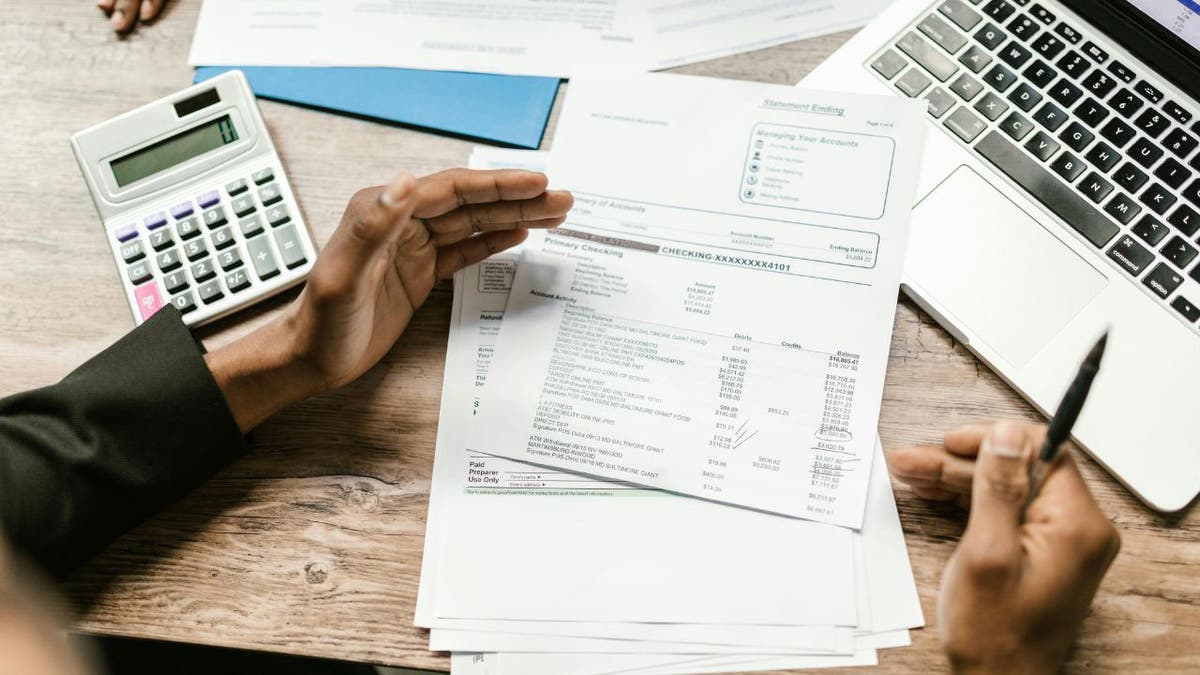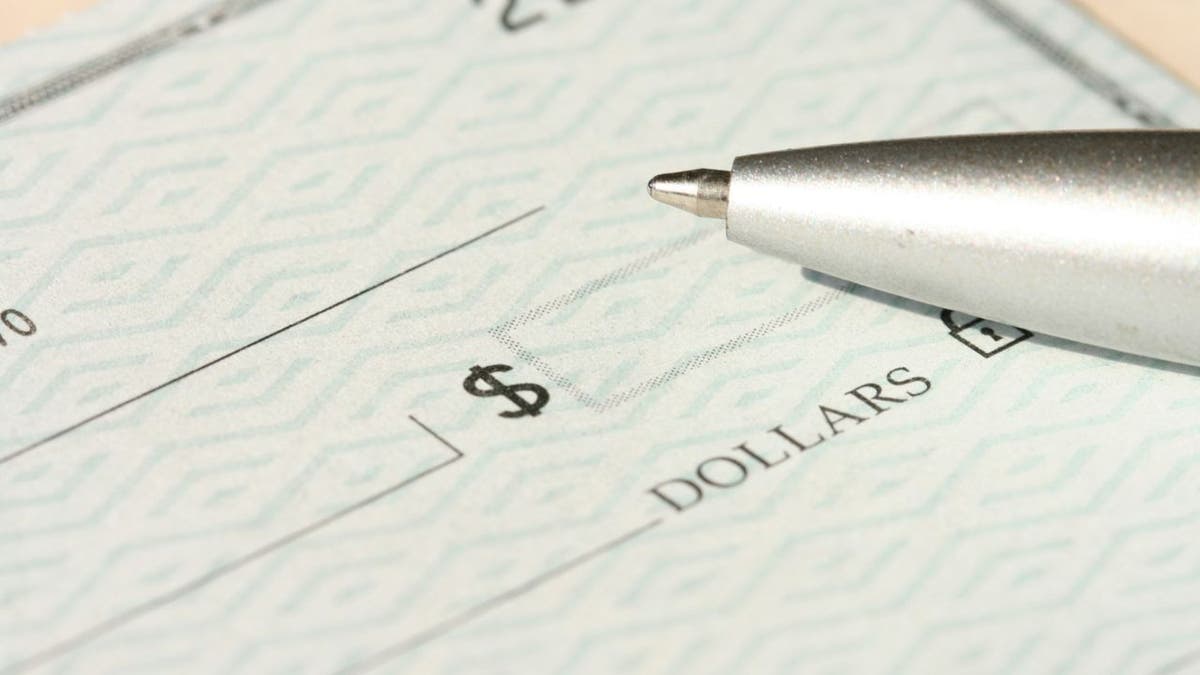Once considered a fashion crime, checking the washing has returned to life with alarming sophistication.
The criminals are no longer oriented to personal controls. They are exploiting all the vulnerability of the email and banking system to collect stolen funds.
As check fraud incidents continue to increase abruptly throughout the country, it is more important than ever to understand how the washing works and what you can do to protect you. Here is what you need to know to keep you in front of the scammers.
Join the Free Cyberguy report: Get my expert technology tips, critical security alerts and exclusive offers, as well as instantaneous access to my free scam survival guide when you register.
A pen placed on top of a blank (Kurt “Cyberguy” Knutsson)
What is washing control?
Washing fraud occurs when a scammer steps a check you wrote, erases ink through chemicals such as acetone or enamel remover and rewrite it to a new recipient. They will often change the amount to something much higher. The altered check is deposited or charged and the funds are drained from your account before you even realize that something goes wrong.
Why is dangerous:
- Checking the washing does not require much technical skill.
- It can pass by checks that you leave in your outgoing mail.
- Even paid invoices sent are vulnerable if they are not managed safely.
The FBI warns the scam aimed at victims with fake hospitals and police
Unlike digital fraud, check the washing often unnoticed until much after the damage is done. As checks may take days or even weeks to erase -through the banking system, criminals have a lot of time to deposit altered controls and move funds before victims realize that anything is not working.
When you discover the missing money, trace it to the scammer can be extremely difficult. This delay makes it essential to closely control your accounts and act quickly if you detect any suspicious activity.

Illustration of the ongoing check fraud (Kurt “Cyberguy” Knutsson)
The FBI warns the scam aimed at victims with fake hospitals and police
How to get worse the washing
Since 2023, the verification fraud has exploded in the United States.
The increase in fraud reports reflects more than isolated criminal acts. Organized crime rings are re -verified as a hybrid crime, mixing old -school mail theft with new digital tools such as AI. Defrauders now use advanced technologies to forge identities, alter images and exploit gaps in bank safety, making the washing more sophisticated than ever. As financial institutions strengthen cybersecurity defenses, scammers are aimed at physical mail systems as a weakest link to avoid digital barriers.
Real examples:
- Six people were accused of trying to steal $ 80 million through fraudulent checks Tied to the background of Covid-19 relief.
- In Florida, an old mail carrier was guilty of trying to sell USPS arrow keys and stolen checks for $ 550,000 to a covert agent, causing his arrest and confession.
s
New tricks are using criminals
Defrauders have adapted their methods to keep in front of the police and banks.
- Mobile deposit fraud: Criminals alter the pictures or deposit the same check in several accounts.
- Synthetic identity fraud: The scammers create false identities through AI -generated documents to open cash accounts and checks.
- Business Email Commitment (BEC): Attackers supplant executives or sellers to convince companies that send checks to fraudulent accounts.
Criminals combine old techniques such as mail theft with new digital strategies, which makes washing more difficult to recognize and prevent without proactive security measures. Recent advances in AI technology have facilitated scammers in creating realistic aspect documents, generate convincing false identities, and create sophisticated phishisteria emails.
False IDS generated by AI and altered verification images can pass basic verification checks that would have caught manual falsifications in the past. This change means that fraud is no longer just a matter of stealing physical control, but also exploit digital vulnerabilities at all stages of the banking process.

A person passing over a bank state (Kurt “Cyberguy” Knutsson)
This is what you are doing wrong when the scammers call
How to protect —s of fraud washing check
The following is 14 essential protection measures to protect the control washing scams.
1. Use a black ice pen: When you write checks, always use a Hangs of black ice. The ink is much harder to remove compared to regular pen ink.
2. Take checks directly to the post office when sending them: If you are using a mailbox, secure the mail before the final collection scheduled so that it is not sitting at night.
3. Sign up -Do to USPS Informed Delivery: Keep -you go forward by registering -vos a Informed Delivery USPS. You will receive the digital previews of incoming mail so you can supervise the missing items early. Get more information about why it is important here.
4. Supervise your bank accounts: Set up alert in real time for check cleaning and review your statements weekly to achieve any suspicious activity. Also ask your bank about any other fraud prevention tool they offer to protect your accounts.
5. Change to digital payments when possible: Use your bank’s mobile application to deposit checks without sending them or physically delivering them, reducing the risk of theft or handling.
6. Use checks with integrated security features: Choose print checks with watermarks, chemical -sensitive coatings or other security functions that make the washing much more difficult.
7. Limit information to checks: Avoid unnecessary personal data. Do not print your Social Security Number, driver’s license number or phone number on your checks. The less available information, the less you can use a defrauder.
As cyberscams are draining the north -american portfolios by the billions
8. Safely store checks: Keep your blank checks in a safe place. Store your checkbook in a locked or secure drawer, not in the bag, in the car or in a location easily accessible at home.
9. Check your mailbox safety: Install at mailbox blocking. If possible, use a mailbox with a lock to prevent thieves from stealing an outgoing or coming mail.
10. Be cautious with evaluations: When you evaluate the checks, write “only by deposit” along with the account number to prevent others from collecting the check.
11. Sign up to the protection against theft of identity with the specialization of verification fraud: Choose services that specifically control the checking details committed in the dark web markets and alert the suspected control box patterns. Identity Theft Protection Services monitor your personal data on the databases of the dark and public web, alert to suspicious activity and help them block the accounts if needed. Check out my tips and the best options on how to protect -you are from theft of identity.
12. Invest in personal data removal services: Minimize the exposure of sensitive details (such as addresses or bank affiliations) that defrauders could exploit for checking scams. Deleting personal information from these sites can help reduce the risk of converting to a victim. While no service can guarantee complete deletion of your Internet data, a data removal service is really a smart choice. They are not cheap and is not your privacy either.
These services do all the work to systematically control and clear the personal information of hundreds of websites. It is what gives me peace of mind and has proven to be the most effective way to delete your personal Internet data. Limiting the information available, reduce the risk of reference fraudster to the breaches with information that they could find on the dark network, which makes it more difficult for them to guide you. Check out my best options for data removal services here.
13. Documents sensitive to crushing: You work old and bank states. Not only do you throw them. Shredled any document with sensitive bank information.
14. Report immediately from suspicious activity: If you suspect you check fraud or email, report it to your bank and to the United States Postal Inspection Service immediately.
15. Use positive pay if you are a business: Positive payment It is a fraud prevention service offered by most banks to business customers. It works to coincide with the checks you issued with those submitted for payment. If something is not achieved, such as a changed amount or a beneficiary, the bank starts it for your review before it is processed. You usually have to sign up through the bank and there may be a quota, but it is a smart way to protect your business from check fraud, especially if you write many checks.
What to do if you are a victim
If you think you have been oriented by a check fraud:
Time is important. The faster it acts, the better it is possible to recover the lost funds.
Kurt’s Key Takeaways
Check that the washing fraud is growing rapidly and criminals are becoming more organized and sophisticated. Simple habits such as using ice pens, secure your mail and closely control your financial accounts can make a big difference. Services such as USPS Delivery, Positive Payment for Companies and Personal Data Deletion Tools provide added protection layers. Identity Theft Protection Services may also offer critical support if you are ever the victim of control fraud.
Click here to get the Fox News app
You or someone you know has experienced a check fraud? Do -us to know by writing -us to Cyberguy.com/contact
For more information on my technology tips and security alerts, subscribe -Free Cyberguy Report Bulletin Cyberguy.com/newsletter
Ask a question to Kurt or to know what stories you would like to cover
Follow Kurt in their social channels
Answers to Cyberguy Questions Most Failed:
New of Kurt:
Copyright 2025 cyberguy.com. All rights reserved.
#Check #Wash #Crisis #Fed #Mail #theft
Image Source : www.foxnews.com
